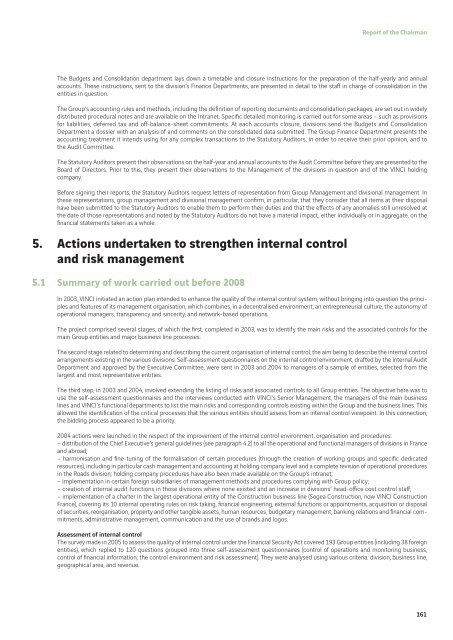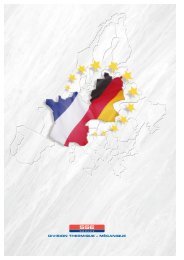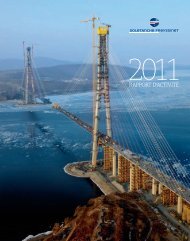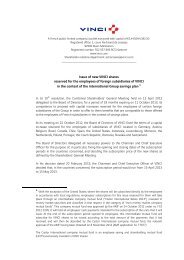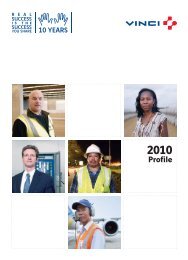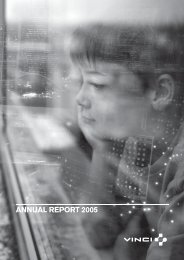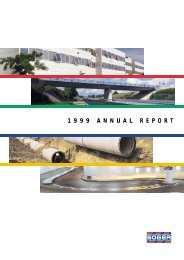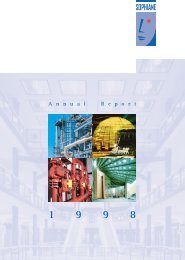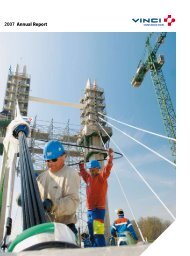VINCI - 2008 annual report
VINCI - 2008 annual report
VINCI - 2008 annual report
Create successful ePaper yourself
Turn your PDF publications into a flip-book with our unique Google optimized e-Paper software.
Report of the Chairman<br />
The Budgets and Consolidation department lays down a timetable and closure instructions for the preparation of the half-yearly and <strong>annual</strong><br />
accounts. These instructions, sent to the division’s Finance Departments, are presented in detail to the staff in charge of consolidation in the<br />
entities in question.<br />
The Group’s accounting rules and methods, including the defi nition of <strong>report</strong>ing documents and consolidation packages, are set out in widely<br />
distributed procedural notes and are available on the Intranet. Specifi c detailed monitoring is carried out for some areas – such as provisions<br />
for liabilities, deferred tax and off -balance-sheet commitments. At each accounts closure, divisions send the Budgets and Consolidation<br />
Department a dossier with an analysis of and comments on the consolidated data submitted. The Group Finance Department presents the<br />
accounting treatment it intends using for any complex transactions to the Statutory Auditors, in order to receive their prior opinion, and to<br />
the Audit Committee.<br />
The Statutory Auditors present their observations on the half-year and <strong>annual</strong> accounts to the Audit Committee before they are presented to the<br />
Board of Directors. Prior to this, they present their observations to the Management of the divisions in question and of the <strong>VINCI</strong> holding<br />
company.<br />
Before signing their <strong>report</strong>s, the Statutory Auditors request letters of representation from Group Management and divisional management. In<br />
these representations, group management and divisional management confi rm, in particular, that they consider that all items at their disposal<br />
have been submitted to the Statutory Auditors to enable them to perform their duties and that the eff ects of any anomalies still unresolved at<br />
the date of those representations and noted by the Statutory Auditors do not have a material impact, either individually or in aggregate, on the<br />
fi nancial statements taken as a whole.<br />
5. Actions undertaken to strengthen internal control<br />
and risk management<br />
5.1 Summary of work carried out before <strong>2008</strong><br />
In 2003, <strong>VINCI</strong> initiated an action plan intended to enhance the quality of the internal control system, without bringing into question the principles<br />
and features of its management organisation, which combines, in a decentralised environment, an entrepreneurial culture, the autonomy of<br />
operational managers, transparency and sincerity, and network-based operations.<br />
The project comprised several stages, of which the fi rst, completed in 2003, was to identify the main risks and the associated controls for the<br />
main Group entities and major business line processes.<br />
The second stage related to determining and describing the current organisation of internal control, the aim being to describe the internal control<br />
arrangements existing in the various divisions. Self-assessment questionnaires on the internal control environment, drafted by the Internal Audit<br />
Department and approved by the Executive Committee, were sent in 2003 and 2004 to managers of a sample of entities, selected from the<br />
largest and most representative entities.<br />
The third step, in 2003 and 2004, involved extending the listing of risks and associated controls to all Group entities. The objective here was to<br />
use the self-assessment questionnaires and the interviews conducted with <strong>VINCI</strong>’s Senior Management, the managers of the main business<br />
lines and <strong>VINCI</strong>’s functional departments to list the main risks and corresponding controls existing within the Group and the business lines. This<br />
allowed the identifi cation of the critical processes that the various entities should assess from an internal control viewpoint. In this connection,<br />
the bidding process appeared to be a priority.<br />
2004 actions were launched in the respect of the improvement of the internal control environment, organisation and procedures:<br />
– distribution of the Chief Executive’s general guidelines (see paragraph 4.2) to all the operational and functional managers of divisions in France<br />
and abroad;<br />
– harmonisation and fi ne-tuning of the formalisation of certain procedures (through the creation of working groups and specifi c dedicated<br />
resources), including in particular cash management and accounting at holding company level and a complete revision of operational procedures<br />
in the Roads division; holding company procedures have also been made available on the Group’s intranet;<br />
– implementation in certain foreign subsidiaries of management methods and procedures complying with Group policy;<br />
– creation of internal audit functions in those divisions where none existed and an increase in divisions’ head-offi ce cost control staff ;<br />
– implementation of a charter in the largest operational entity of the Construction business line (Sogea Construction, now <strong>VINCI</strong> Construction<br />
France), covering its 10 internal operating rules on risk taking, fi nancial engineering, external functions or appointments, acquisition or disposal<br />
of securities, reorganisation, property and other tangible assets, human resources, budgetary management, banking relations and fi nancial commitments,<br />
administrative management, communication and the use of brands and logos.<br />
Assessment of internal control<br />
The survey made in 2005 to assess the quality of internal control under the Financial Security Act covered 193 Group entities (including 38 foreign<br />
entities), which replied to 120 questions grouped into three self-assessment questionnaires (control of operations and monitoring business,<br />
control of fi nancial information; the control environment and risk assessment). They were analysed using various criteria: division, business line,<br />
geographical area, and revenue.<br />
161


